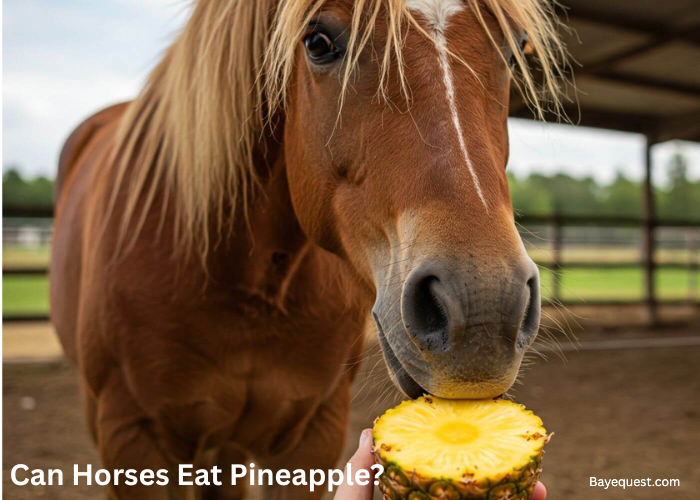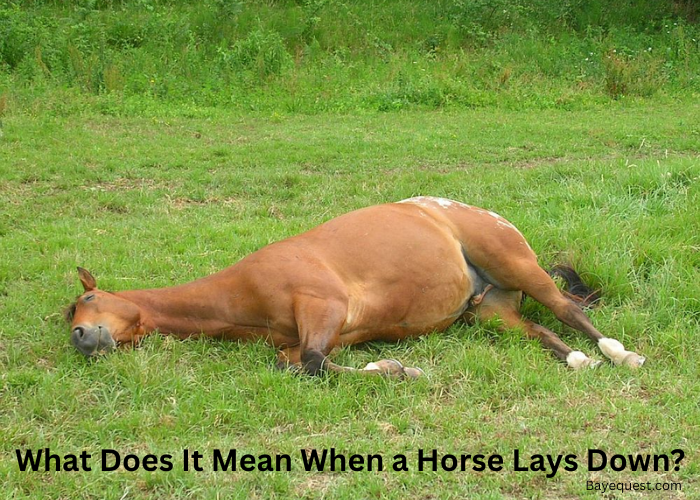Pineapple is sweet and tangy, but is it a suitable treat for horses? Horses mainly eat hay and grass, with fruits adding variety.
Not all fruits are safe. Pineapple contains more sugar, fiber, and acidity than many fruits, so offer it sparingly. Before serving pineapple, understand its safety, proper portions, and the best varieties.
This article reviews pineapple’s nutritional value, provides guidelines for offering it as a treat, and explains how to safely prepare pineapples for your horse. Read on for more details.
Can Horses Eat Pineapple? Key Takeaway
Horses can eat small amounts of fresh, peeled pineapple as an occasional treat. Avoid canned pineapple, including its skin and core, to prevent health issues. Pineapple adds hydration and flavor without upsetting your horse’s diet. Remember to feed this treat alongside regular forage and grain rations.
Nutritional Value of Pineapple for Horses
Let’s take a closer look at the nutritional value of pineapple for horses.
Vitamins
Pineapple contains vitamin C, which supports immune health. It also includes vitamin A, which aids vision and skin repair.
Minerals
Pineapples contain small amounts of calcium and magnesium. These minerals promote bone strength and muscle function.
Water
Pineapple is roughly 85–87% water, helping with hydration, especially during hot months.
Potassium
This electrolyte supports nerve and muscle function. Feeding pineapple to active horses helps replenish potassium lost through sweating.
Sugars
Natural fructose and glucose offer quick energy. However, horses require sugar in moderation to prevent digestive upset.
| Nutrient | Approx. per 100 g pineapple | Role in horse health |
| Vitamin C | 9 mg | Immune support |
| Potassium | 110 mg | Electrolyte balance |
| Calcium | 13 mg | Bone maintenance |
| Magnesium | 12 mg | Muscle and nerve support |
| Sugar | 9 g | Quick energy — limit intake |
| Fiber | 1 g | Aids digestion |
Is Pineapple Safe for Horses?
Here’s why you should offer pineapple as an occasional treat for your equine partner;
General safety overview
If properly prepared, pineapple is safe for most healthy horses. The soft flesh provides hydration and nutrients, but its sweetness means it should be fed sparingly.
Excess sugar can cause stomach upset or mild colic, and its acidity may bother horses with sensitive mouths or stomachs if eaten often.
Evaluate each horse individually. Healthy horses can enjoy small portions occasionally as part of a balanced diet. Horses with EMS, insulin resistance, or laminitis should not have high-sugar fruits.
Even small amounts of sugary treats can spike glucose and insulin levels. Consult a nutritionist before introducing pineapple.
Occasional treat vs regular addition
Pineapple should only be an occasional treat, not a regular part of your horse’s diet. Treats, including fruit, should make up no more than 10 percent of daily intake.
Too much pineapple can upset digestion, so use it as a special reward.

Forms of Pineapple and Which Are Safe
Pineapple’s safety for horses depends on how it is prepared.
Fresh pineapple
Only feed fresh pineapple, peeled and cored, cut into small pieces for easy chewing. Fresh pineapple has the right texture, moisture, and less sugar than processed types.
Frozen pineapple
Frozen pineapple is acceptable in small quantities, especially on warm days. Thaw pieces until soft, as hard frozen fruit may harm your horse’s teeth or cause choking.
Canned pineapple
Do not feed canned pineapple to horses. Most canned pineapples contain syrup, citric acid, or preservatives.
These artificial fillers make it too sweet and acidic. Even unsweetened canned pineapple is unsuitable since it’s more concentrated than fresh fruit.
Pineapple skin and core
Never feed pineapple skin or core to your horse. The outer rind is rough and can hurt their mouth or throat.
The core is tough to chew and can cause choking or stomach problems.
Potential Risks of Feeding Pineapple to Horses
Fruits, including pineapples, can cause problems when fed incorrectly or in large amounts,
Digestive and metabolic concerns
The equine digestive system is adapted for continuous grazing on high-fiber, low-sugar forage. Pineapple’s natural sugars can disrupt this balance if fed excessively, leading to bloating, gas, loose manure, or mild colic.
In sensitive horses, even small amounts can raise blood glucose and increase metabolic strain, potentially contributing to laminitis.
While the acidity is usually tolerated, it may worsen discomfort in horses with gastric ulcers or oral lesions.
Choking and preparation risks
Pineapple’s texture can be tricky. Its tough, fibrous parts require careful preparation. Large pieces can cause choking, especially for horses that eat quickly or have worn teeth.
Always peel the pineapple, remove the core, and cut the fruit into small, bite-sized pieces. Offer these by hand or in a bucket so your horse eats slowly.
Allergic or individual reactions
Some horses react poorly to tropical fruits. They may have mild colic, muzzle itching, or reduced intake.
Introduce pineapple slowly in small amounts and observe your horse for 24 hours. Monitor manure, appetite, and behavior for negative signs.
Practical Tips for Feeding Pineapple to Horses
Here are some simple tips to help you feed pineapple safely;
Introducing pineapple safely
Start small. Offer one or two small cubes (50–100 grams) and wait 24 hours. Monitor manure, appetite, and behavior. If there is no reaction, keep using pineapple as an occasional treat.
Test new foods one at a time. Introducing several treats at once makes it hard to tell which one caused a reaction. Horses are creatures of habit, so gradual changes protect their sensitive digestion.
Best preparation methods
Proper preparation ensures both safety and palatability.
- Remove outer skin, eyes, leaves, and core completely, as these fibrous parts are tough to chew and may irritate the mouth or throat.
- Cut the fruit into small, bite-sized cubes that can be easily chewed and swallowed. Avoid wedges or rings that encourage big bites.
- Rinse the pieces lightly under water to remove excess juice and acidity. This reduces stickiness and prevents residue buildup around the muzzle.
- Serve at room temperature or lightly chilled, especially on hot days. Avoid feeding frozen solid pineapple, as it can be too hard on teeth and increase the risk of choking.
- You may also place the cubes in a slow feeder or bucket to encourage controlled eating.
Recommended portion sizes for horses
Moderation is key. An adult horse (about 450 kg) should have only 1–2 cups of diced pineapple per week.
Ponies, minis, and young horses should get just a few small pieces. Too many treats reduce the value of regular hay, grain, and supplements.
Combining pineapple with other safe fruits
To add variety, pair pineapple with low-sugar fruits and vegetables. Carrot sticks, apple slices, cucumber rounds, or watermelon cubes are suitable additions.
Mixing these treats offers texture and flavor diversity without overloading on sugar. Avoid combining pineapple with grapes, bananas, mangoes, and other sugary fruits..
When to avoid feeding pineapple to horses
Don’t feed pineapple to horses with metabolic problems, dental issues, or sensitive digestion. Horses recovering from colic, ulcers, or laminitis should avoid sugary fruits. Older horses with worn teeth may also have trouble chewing pineapple. Focus on good hay and balanced feed first, and offer treats as a bonus, not a necessity.

Signs Pineapple Doesn’t Agree with Your Horse
While pineapple is safe for many horses, some may not tolerate it because of its sugar and mild acidity.
Loose stool or diarrhea
This is the most common sign that pineapple doesn’t agree with your horse. The sugars and fiber in pineapple can change the gut bacteria, leading to watery or soft manure.
If you stop feeding the fruit, mild cases usually clear up in a day. Ongoing diarrhea can cause dehydration and upset the horse’s electrolyte balance.
Lack of appetite and lethargy
If your horse eats less or seems tired after eating pineapple, it could mean their stomach is upset.
A horse that usually eats well might hesitate at the feed bucket or graze less. This can happen if the fruit’s acidity or sugar bothers their stomach or intestines.
Lethargy, slow movements, or a lack of interaction can signal mild colic or bloating. Always take these signs seriously, as small problems can worsen quickly.
Bloating and flatulence
Bloating occurs when fruit sugars ferment excessively in the hindgut. You might notice a swollen belly, frequent gas sounds, or the horse glancing at its flank. Some may paw, shift weight, or appear uneasy while standing.
You can manage this condition by restricting the horse to a forage-only diet. Also, walking gently will relieve gas pressure. Consult a vet if bloating lasts more than a few hours.
Irritability and restlessness
Pay attention to your horse’s mood. If they seem irritable or restless, it could be a sign of stomach pain. They might pin their ears, swish their tail, toss their head, or avoid being groomed or saddled.
These changes can happen before you see any physical symptoms. Since horses often hide pain, noticing mood changes after new foods is important.
If your usually calm horse seems anxious or upset, pineapple might be the cause.
Swelling around the muzzle
Redness or tenderness may result from pineapple’s acidity or bromelain enzymes. Some horses develop mild irritation around the lips, nostrils, or tongue.
This discomfort leads to reluctance when bridled or touched near the face. This can appear shortly after eating the fruit, especially if the pieces were not rinsed well.
Alternatives to Pineapple: What Other Fruits Can Horses Eat?
Below are several horse-friendly fruits that deliver nutrients without overwhelming the digestive system.
1. Carrots
Carrots are among the most popular horse treats. They’re naturally sweet but lower in sugar than tropical fruits like pineapple.
Rich in beta-carotene, they support vision and immune function. Feed raw carrot sticks or thin slices to prevent choking, and limit to a few pieces daily to avoid excess sugar.
2. Apples
Apples contain water, fiber, and vitamin C. Always remove the core and seeds before feeding apples to horses. The seeds contain cyanide that irritates their digestive tract, especially in large amounts.
Sliced apples make an easy training reward or mix-in for other fruits. Avoid feeding more than one small apple per day to maintain balance.
3. Pears
Like apples, pears are high in fiber and moisture. Their mild sweetness makes them ideal for horses sensitive to acidic foods.
Remove the core and seeds to reduce the risk of choking. Diced pear pieces are a gentle, hydrating option, especially for older horses. Pears are also great for horses recovering from mild digestive upset.
4. Watermelon
Watermelon is one of the most hydrating fruits available for horses. Both the red flesh and the green rind are safe to eat and offer vitamins A and C, as well as electrolytes.
Cut watermelon into cubes or wedges to make it easier to chew. Because it’s mostly water, it’s perfect for hot days or post-workout hydration.
Read also: How Much Watermelon Can a Horse Eat?
5. Blueberries
Blueberries are nutrient-dense and contain antioxidants that support cell repair and immune function.
Their small size makes them easy to feed, and their low sugar content makes them suitable for horses on restricted diets. Offer a small handful at a time and mix with hay cubes or pellets for variety.
6. Strawberries
Strawberries provide natural sweetness and vitamin C without excessive sugar. Wash thoroughly to remove pesticide residue, and feed a few at a time.
Their soft texture makes them suitable for horses with dental issues. Strawberries can also be combined with other fruits for a colorful, nutrient-rich mix.
7. Bananas
Bananas deliver potassium, vitamin B6, and quick energy. Horses can safely eat the peel and the flesh, though some prefer only the soft interior.
Slice into rounds to reduce waste and make chewing easier. Bananas are good before or after light exercise for an immediate energy boost.
8. Pumpkin
Fresh pumpkin is a fiber-rich option that supports healthy digestion. Remove the seeds and cut the flesh into cubes before feeding.
Pumpkin is lower in sugar than most fruits and is a good source of beta-carotene. These nutrients promote skin and coat health, making it a great seasonal alternative.
9. Grapes
Grapes are small, juicy, and easy to feed by hand. They also contain antioxidants that promote cardiovascular health.
However, their sugar content is moderate to high, so limit them to a handful per week. Always wash grapes thoroughly before serving to remove chemical residues.
FAQs
Can horses eat pineapple skin?
No. Pineapple skin is tough, spiky, and fibrous, making it unsafe for horses to chew or swallow. The rough texture can cut the lips, tongue, or throat and may cause choking or digestive blockage if eaten. Always remove the outer rind, eyes, and crown before feeding pineapple.
Can horses eat pineapple every day?
Feeding pineapple daily is not recommended. Pineapple’s high sugar and acidity can upset the horse’s sensitive digestive system. This raises the risk of laminitis, especially in insulin-resistant or overweight horses. Offer pineapple in small portions, after regular forage, to avoid gut imbalance.
Can horses eat pineapple seeds?
Most pineapples contain few visible seeds. While they’re generally harmless in small amounts, it’s best to remove them before feeding. Horses have delicate digestive tracts, and small, hard objects can irritate the stomach or cause mild impaction. Always inspect and prepare pineapples, offering only soft, seed-free pieces for safe consumption.
Can horses drink pineapple juice?
No. Pineapple juice may seem refreshing, but it’s just concentrated sugar water with no fiber. This makes it too sweet and acidic for a horse’s digestive system. Even diluted juice can cause bloating or loose stool. Always choose solid fruit pieces instead, as fiber helps regulate sugar absorption and maintains gut health.
Conclusion
Pineapple can be a tasty, healthy treat for your horse if used carefully. Fresh, peeled pieces provide hydration, vitamins, and variety, but should make up only a small part of the diet.
Avoid canned, sweetened, or unprepared pineapple, and always watch your horse’s reaction. When given in the right amount, pineapple is a safe, enjoyable reward.
Always offer treats after providing regular forage and grain meals. Careful treat management helps your horse stay healthy, happy, and ready for the next snack.








